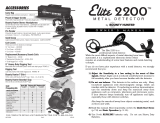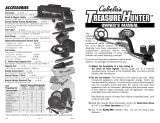
19
5-YEAR LIMITED WARRANTY
The Legacy 1500 metal detector is warranted against defects in materials and
workmanship under normal use for five years from the date of purchase to the origi-
nal owner.
Damage due to neglect, accidental damage, or misuse of this product is not cov-
ered under this warranty. Decisions regarding abuse or misuse of the detector
are made solely at the discretion of the manufacturer.
Proof of Purchase is required to make a claim under this warranty.
Liability under this Warranty is limited to replacing or repairing, at our option, the
metal detector returned, shipping cost prepaid to First Texas Products. Shipping
cost to First Texas Products is the responsibility of the consumer.
To return your detector for service, please first contact First Texas for a Return
Authorization (RA) Number. Reference the RA number on your package and
return the detector within 15 days of calling to:
First Texas Products L.L.C.
1465-H Henry Brennan Dr.
El Paso, TX 79936
Phone: 915-225-0333
NOTE TO CUSTOMERS OUTSIDE THE U.S.A.
This warranty may vary in other countries, check with your distributor for details.
Warranty does not cover shipping costs.
According to FCC part 15.21 Changes or Modifications made to this device not expressly approved by
the party responsible for compliance could void the users authority to operate this equipment.
This device complies with FCC Part 15 Subpart B Section 15.109 Class B.
Copyright
©
2013 by First Texas Products, L.L.C.
All rights reserved, including the right to reproduce this book, or parts thereof, in any form,
except for the inclusion of brief quotations in a review.
Published by First Texas Products, L.LC.
Bounty Hunter
®
is a registered trademark of First Texas Products, L.L.C.
www.detecting.com
1465-H Henry Brennan • El Paso, TX 79936 • (915) 633-8354
MADE IN U.S.A.
TREASURE HUNTER’S CODE OF ETHICS:
• Always check Federal, State, County and local laws before searching.
• Respect private property and do not enter private property without the owner’s permission.
• Take care to refill all holes and leave no damage.
• Remove and dispose of any and all trash and litter found.
• Appreciate and protect our inheritance of natural resources, wildlife and private property.
• Act as an ambassador for the hobby, use thoughtfulness, consideration and courtesy at all times.
• Never destroy historical or archaeological treasures.
• All treasure hunters may be judged by the example you set; always conduct yourself with
courtesy and consideration of others

































